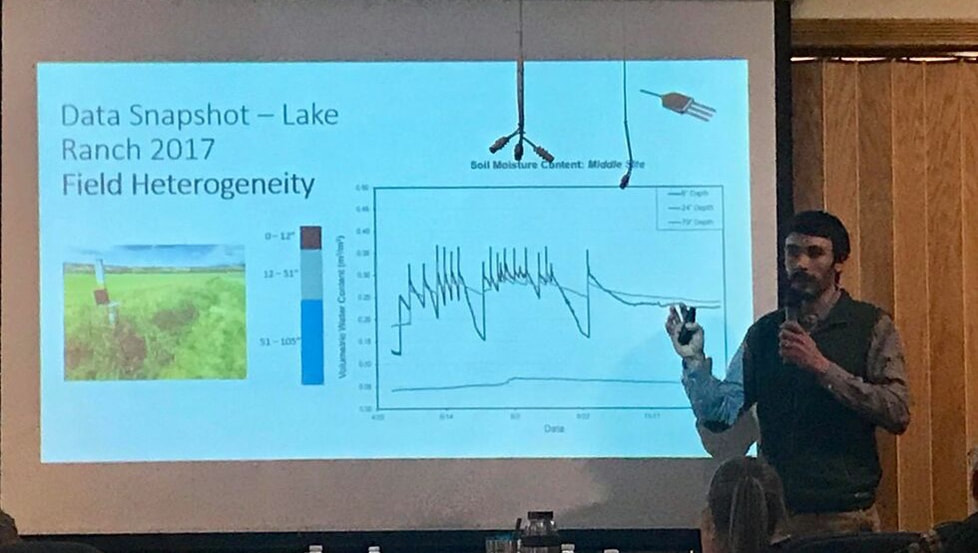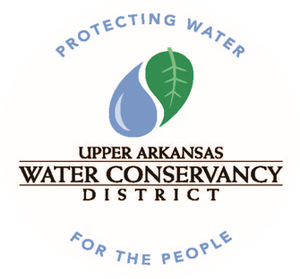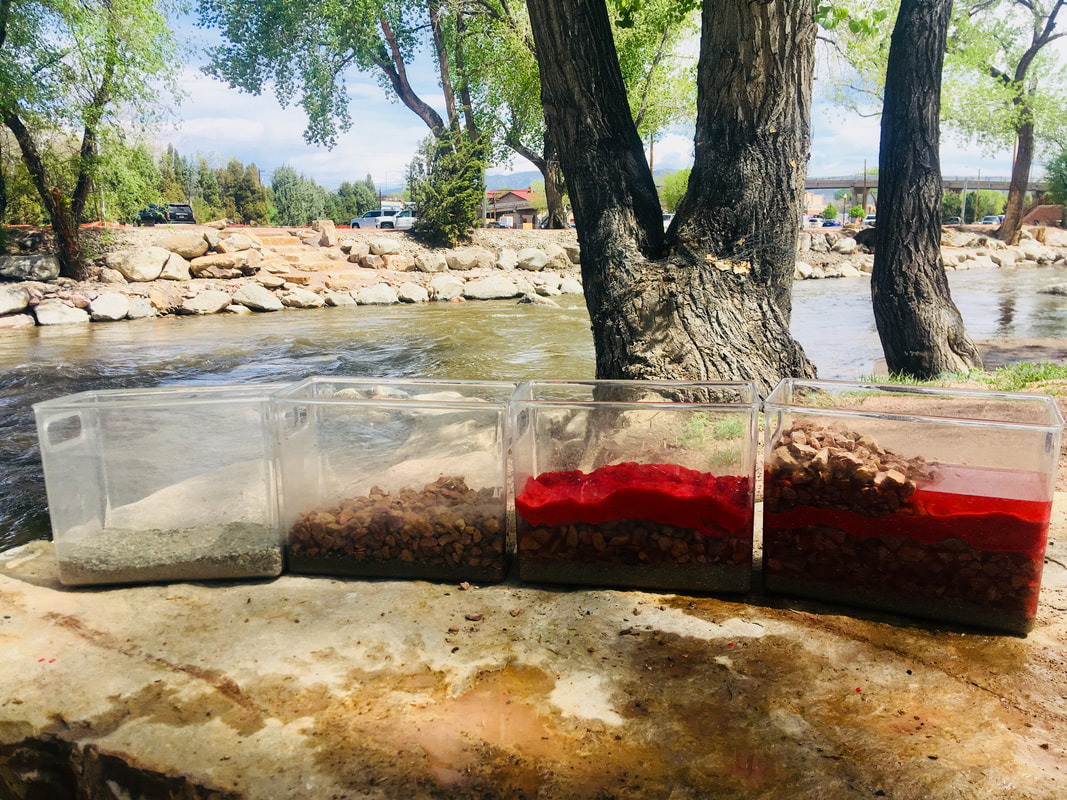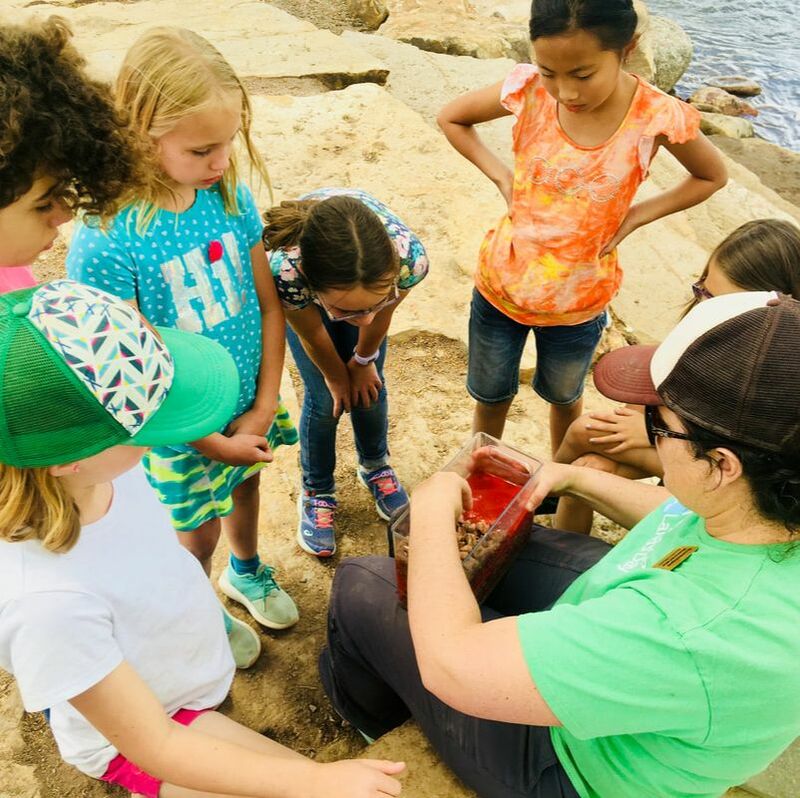By Ralph "Terry" Scanga, General ManagerThe misreading of Section 5, Article 16 of the Colorado Constitution has led many citizens to mistakenly assume that all the water of the state belongs exclusively to the public. This section states:
“The water of every natural stream, not heretofore appropriated, within the state of Colorado, is hereby declared to be the property of the public, and the same is dedicated to the use of the people of the state, subject to appropriation as hereinafter provided.” Essentially the waters are the property of the public for appropriation to beneficial use. The ownership of the water by the public is conditioned upon it not being appropriated. Further the water is dedicated to the people for appropriation for beneficial use. In the Arkansas Basin every drop of water in the natural streams is appropriated and thereby owned by individual entities, private and public. Due to the above misreading and misunderstanding of ownership a tension between private rights and public rights to water has existed. Importantly, Colorado is not a public trust state. Thus, the waters of the state are not “held in trust” for the public, rather, they are dedicated to the people of the state for appropriation and use. The statute therein creates the ability for individuals to acquire a private ownership of water—a water right confirmed by court decree through a priority of use date. Some incorrectly argue that a water right is a usufructuary right, which is technically correct. A usufructuary right refers to one individual’s right to use the property of another provided that the right is not altered or impaired. A Colorado water right is different, it is alienable. That is, it may be changed and transferred to another type of use, place of use, or manner of use. The priority of use has historically been viewed as a private property right that can be separated from the land upon which it is used. The water right itself can be separated and transferred from the land upon which it was historically used and may be purchased separately from the land. Although water rights are property rights and are considered realty, they can be abandoned, thus they are a possessory right. For nearly 150 years water in Colorado has been allocated by prior appropriation. Especially in the arid Western half of the USA this system that establishes these property rights is called the “Colorado Doctrine”. When the interior of the Western United States was developed Colorado was the trailblazer on water appropriation. The West needed miners, ranchers, and farmers to develop its resources and build a viable economy through hard work. During this early development period the average citizen mistrusted government and large monopolistic enterprises and feared the creation of a system that would facilitate collusion between government and these corporations. To best use the water resources of Colorado the prior appropriation doctrine was adopted to create the incentive for resourceful individuals to divert waters of the state and place them to uses that would develop vibrant economies. The system that was adopted prevented wealth speculators from hoarding water and creating a windfall profit. The language in the Colorado Constitution does just that. Public refers to the people individually given the right to appropriate water and place it to beneficial use and thereby creating a private property right. By law the amount of water so appropriated must be beneficially used without waste. Irrigation water rights are allocated by a ratio of a volume or rate of water to a specific amount of acreage. This is termed the “duty of the water right”. From this ratio and historic practice is derived the specific amount of water that an individual water right owner owns, stated in acre feet. The number of acre feet owned is what can be transferred for use in different locations or transferred to a different type or manner of use. In order to protect other vested water rights a transfer must be confirmed by the water court and a new or a change decree issued. Through the water allocation and use mechanisms developed in the Colorado Doctrine, Colorado citizens have been able to optimize the use of incalculable value in an arid region of the United States.
3 Comments
This is part two of a two-part series by General Manager, Ralph "Terry" Scanga. To read part one, click here.
Threats to Water Use In terms of water supply the greatest threat for the future would be a loss or erosion through legislative or administrative action of the time-tested Colorado Doctrine of prior appropriation. Actions are underway to use the water plan as a framework to advocate instead for the use of policy to appropriate water. Using policy for water appropriation would give the administration and legislature a pathway or initiative to utilize legislation in lieu of the more deliberate Appropriation system that is designed to protect existing water rights from injury. This strongly suggests that the legislature and administration may attempt to act upon perceived crises to garner support to move future appropriations or changes of current water use through legislation instead of the water court system. Already underway is a Demand Management Plan that will allow administrative policies to transfer water rights from agriculture through Deficit Irrigation or by utilizing an undefined process termed “Conserved Consumptive Use” to Lake Powell or to municipal use. In the Arkansas Basin most irrigation is already in a deficit so there is no water to be saved. Under Colorado’s pure form of prior appropriation, in low flow periods, water rights are curtailed automatically to force reductions in use. There is no need to use state policy to create conservation. The frightening part of these actions is that if successful the only way for water right owners to protect themselves from injury will be expensive court action. If legislation is successful in adopting the concept of “Conserved Consumptive Use” it is possible we will see lower flows in the Arkansas River due to a reduction in trans-mountain diversions. These diversions support all uses in the river such as the voluntary flow management program. Instead of water flowing to the Arkansas River some may flow down the Colorado River to Lake Powell for storage and eventual evaporation there under a plan called Demand Management. Water Quality In the Upper Arkansas Basin water quality has been addressed is various ways. The Arkansas River was polluted by mining runoff and is normally by natural geologic formations. Most of this pollution has been cleaned-up and today there are large sections of gold medal fishing. Studies conducted by the US Geological Survey have concluded that most of our ground water is of good quality. These are good things. But the threat to water quality from sediment runoff from burn areas in our forests are real. Due to the beetle infestations and decimation of the forest stands in the US Forest lands fire is more likely and has occurred. The after effects of fire is larger than normal storm runoff. This will and has already caused heavy sediment loading on our streams and the Arkansas River. The Upper Arkansas Water Conservancy District (UAWCD) and the Arkansas Basin Roundtable is working with the US Forest Service and local entities to address some of these areas. Locally, the UAWCD is working with the Forest Service on a pilot project to remove beetle killed forest stands and make it a commercially viable resource. If successful, this may be be part of the solution. In the lower part of the Upper Arkansas River Basin, in Eastern Fremont County, there is a geologic formation that contains selenium that contributes to contamination in this part of the Arkansas River. At this time simply identifying these areas is a challenge but is being worked on by the US Geological Survey. Most of this type contamination mostly affects the Lower Arkansas Basin. Delivery of good municipal drinking water supplies is being undertaken by the South Eastern Colorado Water Conservancy District with the construction of a pipeline from Pueblo Reservoir to the Lower Basin communities. fBy Ken Baker - Board Consultant
The Colorado General Assembly for 2019 will soon draw to a close. In past legislative sessions, bills that did not receive CWC State Affairs Committee vote of approval may have been assigned to a committee for further discussion and review. In the present General Assembly such bills commonly were referred to a committee and approved, received Chamber vote, and eventually were sent to the Governor’s office. The following are some bills of interest. HB 19-1082: Ditch Bill - Concerning the Rights of a Water Right Easement Holder This bill confirms the right of a ditch easement owner to clean and repair the ditch to a condition that the ditch will carry the water adjudicated to flow in the ditch. The bill was sponsored in response to a ditch owner’s complaint that a landowner whose land was subject to the easement tried to restrict the ditch owner from cleaning and repairing the ditch. The law now gives the ditch easement owner the right to repair, maintain, and improve the ditch with ditch lining and culvert. Ditch owners in the Arkansas River Basin may find that the 1995 Amended Rules and Regulations ordered by the Water Court to comply with the 1948 Treaty Agreement between the State of Kansas and the State of Colorado may restrict ditch lining. SB 19-186: Concerning the Expansion of Agricultural Chemical Management Plans to Protect Surface Water Under current law, the commissioner of agriculture is responsible for the management of the use of agricultural chemicals to protect groundwater and the commissioner adopts rules establishing agricultural management plans for this purpose. This bill expands the scope of commissioner’s agricultural management plans to include the protection of state waters, which include surface and subsurface water. There should be an amendment in the Finance Committee. It would require consultation with a pesticide advisory committee. HB 19-1279: Fire Fighters Foam Control Act- Prohibits Class B Foam This bill has a lot of implications for water and waste water. There are some things in the language that need to be addressed. An amendment would include adding helicopter landing pads and other kinds of firefighting foam testing not currently in the bill. HB 19-1303 Concerning the grant of immunity from liability for a landowner relative to the landowner’s failure to warn against a known dangerous condition on landowner’s land when the landowner has granted a person access for use of the land for recreational purposes without charging the person a fee. This bill was postponed indefinitely. HB 19-1218 Concerning the Colorado Water Conservation Board’s authority to use water that a water right owner voluntarily loans to the Board for instream flow purposes. This bill was killed in committee. HB 19-1271 Concerning a clarification of the authority of the Colorado Water Conservation Board to augment stream flows with acquired water rights that have been previously decreed for augmentation. This bill was killed in committee. HB 19-1327 Concerning sports betting and, in connection therewith, submitting to the registered electors of the state of Colorado a ballot measure authorizing the collection of a tax on the net proceeds of sports betting through licensed casinos and directing the revenues generated through collection of the sports betting tax to specified public purposes, including the state water plan through creation of the water plan implementation cash fund. Since this is a referred measure, it needs only a simple majority in the House and the Senate, and then goes to the Secretary of State who places it as a voter ballot issue in the November election. If approved by the voters, it becomes law without the Governor’s signature. Waters of the United States Click the button below to read comments by Doug Kemper, Executive Director of the Colorado Water Congress. Mr. Kemper's letter concerns the proposed rule on the revised definition of "Waters of the United States". Check out this recent article published in the Ark Valley Voice with comments by Manager Scanga. Special thanks to Henry John DeKam for reaching out to the Upper Ark and for providing important and relevant information to the community.
This is part one of a two-part series by General Manager, Ralph "Terry" Scanga
Most discussions involving water supply or quality require a good examination of historical perspective of water development. For this reason, understanding the system by which water is and has been allocated in Colorado since statehood is a good starting point. Water in Colorado is allocated as a private property right through a system referred to as the Appropriation Doctrine. It is the only arid Western state that utilizes a pure form of this doctrine called the “Colorado Doctrine”. This doctrine is enshrined in the State’s constitution. It is a constitutional right for the citizens of Colorado to an appropriation of water based on its beneficial use. Although many legislative statutes deal with water appropriation and use these all rely upon and must comport with the basic constitutional right granted the citizens of the state. This article is not intended to delve into the Doctrine except to point out that water rights and decrees are granted as a private property right. In fact, this system is automatically designed to apportion available water supply without undue interference from government except for the administration of the existing water decrees or through the water court. In 2005 legislation was passed creating the inter-basin compact committee and the nine basin roundtables. The basins utilized the Statewide Water Supply Initiative (A project to calculate the available water supply compared to demand --a needs assessment) to identify the projects and processes needed to address any water supply gap out to the year 2050 for all uses- municipal, industrial, irrigation (agricultural), environmental and recreational. Water entities and individuals were involved in each basin throughout the state to develop these plans. Projects were identified and some were funded in part with grants from the state’s Colorado Water Conservation Board. The Colorado Water Plan was developed from these plans and processes. These projects have gone a long way to make available the necessary water supplies for the future. Many of the projects are ongoing and more will be needed to meet future needs. Colorado is an arid state with future shortages forecast in the higher growth regions. In the Arkansas Basin many junior water rights were established during high precipitation periods. Due to this the Arkansas Basin today is considered an over-appropriated basin; meaning that on average there are more decreed water rights than water available. Most of these junior water rights are decreed for irrigation use in agriculture. In the Arkansas Basin shortages are forecast for all water uses. The Colorado Water Plan is a collection of the ideas and projects on how we can meet future water demands. Meeting the future need revolves around developing new Colorado River Supplies and Alternative Agricultural Transfers coupled with storage. The Colorado River normally has water that is unused and could be utilized to fill the gaps in the higher growth regions. Presently Colorado is well ahead in meeting its Compact obligations on the Colorado River despite unsubstantiated claims from some state politicians and the administration that Colorado may be unable to meet its obligations. Agricultural irrigation uses 80 percent or more of the available supply statewide. Some of these uses could be temporarily interrupted through court approved Lease-Fallowing agreements, and the water owner compensated, to meet shortages in drier years. In wet years existing storage and new storage could be utilized to save the excess for drier times. Storage projects including alluvial storage need to be built to meet the future needs. Through the existing Appropriation System, the above plans and others are underway to meet this future need. Water storage operations could be adapted to meet multiple uses for stream management to meet increased demands for the environment and recreation. All this can and should be completed through the Colorado Doctrine of Appropriation, a strong legal framework to guarantee the security, reliability and flexibility in the development and protection of water resources. In our next “Water Talks” article we will explore the various threats to our water supply. By Ken Baker - Board Consultant
The Colorado General Assembly is in session and the Upper Arkansas Water Conservancy District is closely monitoring water-related legislation. In our March legislative update I have highlighted some of the issues we are closely following. Change in Republican River District Boundaries HB19-1029 will require a larger number of water users to pay for well pumping in the newly enlarged district. Water Loans for Stream Use HB19-1218 will amend the existing statute that grants authority to the Colorado Water Conservation Board for loaning water for in-stream purposes. Provisions state that the loaned water is to be used for preserving the natural environment of a stream reach that is subject to a decreed in-stream flow right and preserving or improving the natural environment to a reasonable degree for a stream reach for which the Colorado Water Conservation Board does not hold a decreed in-stream right. The bill would increase the number of years of the loan from three years to five years of a ten-year period. Study of Blockchain Technology in Water Uses This bill, SB19-184, is in response to the rapidly emerging technology of blockchain. Governor Polis has announced a major long-term commitment by his administration to make Colorado a hub for the technology of blockchain. Blockchain technology most often associates with crypto-currency, but it has a vast array of uses with respect to asset management, inventory control, product safety, and other applications where security of interchanges is a high priority. SB19-184 authorizes the Colorado Water Institute to study potential uses of blockchain technology in various water applications such as recording and monitoring water rights, developing market exchanges of water, the creation and operation of water banks, aquifer storage retrieval and other applications. When the Institute has completed the study, it will report back to the General Assembly. Restructuring of State Regulations of Oil and Gas Exploration and Extraction HB19-181 proposes major restructuring of the regulatory treatment of the oil and natural gas exploration and extraction industry. Concerning the Expansion of Agricultural Chemical Management Plans to Protect Surface Water SB19-186 is a plan that CSU has worked on with the Department of Agriculture. The word groundwater has been replaced with the term “state waters”.
By Ken Baker, Board Consultant - Upper Arkansas Water Conservancy District The Colorado General Assembly convened on January 4, and the Upper Arkansas Water Conservancy District is closely monitoring water-related legislation. I have highlighted in our January legislative update below, some of the issues being considered by state legislators that we are following. In the coming months, I will continue to update you on their progress and in the meantime, I hope that you find our legislative updates beneficial and informative. The State Plan
The Colorado Governor’s Office has promoted a bill called The State Plan. The plan is basically a theme to develop a water sharing program in which agricultural water rights would be changed to municipal use to be exported to the northern front range of Colorado to supply future water needs of an anticipated population growth. The plan does not contain specifics with respect to water uses to be changed, but at the same time does not specifically include water resources available on the northern front range. Encourage Use of Xeriscape In recent years the General Assembly has passed laws limiting the authority of homeowner’s associations requirements to plant lawns. A current bill will encourage the use of xeriscape in Common Areas. The Upper District will encourage such water rationing promotions. Water exports from rivers in Division No. 2 and Division No. 5 have historically been sources of the historic consumptive use of agricultural appropriations to be transferred to the northern front range. Rationing of water uses within the municipal uses may not represent a complete answer to resolution of water supplies under The State Plan, but it could represent some relief for water managers in the front range communities and in the mountain river valleys asked to satisfy the objectives of The State Plan. Wildfire Mitigation Senate Bill 037 is being introduced to authorize the county commissioners or a private not-for-profit organization to clear the State or Federal lands, within the county, from materials that represent fire hazards. The County of Chaffee has a voter approved tax revenue base to support this proposition. The bill as presented protects the County from liability, unless an employee is negligent or willful in creating damage. The Upper District, through a blanket augmentation plan, provides water resources to address fire hazard prevention projects. The District supports the bill introduced in the Senate. Concerning the Rights of a Water Rights Easement Holder This bill is prompted by ditch owners who want to clear trees along the ditch right-of-way. The bill provides a right to line the ditch to prevent seepage. This could include a pipe in the ditch. Some of the objections to the bill include Amended Rules and Regulations created by Court order to protect return flow rights of the State of Kansas in the Arkansas River under the 1948 Treaty Agreement. A special committee of the CWC State Affairs Committee has been appointed to review and clarify language in the bill. Concerning the Protection of Water Quality from Adverse Impacts Caused by Mineral Mining This bill was presented last year and then withdrawn. The bill is complex. There should be continued discussion on bill language, the roles of water quality and mining entities need to be better defined. by Blake Osborn - Southern Colorado Water Resources Specialist for the Colorado Water Institute and CSU Extension Think back to 3rd grade. Remember learning about the water cycle? It looked good on paper, didn’t it? Water moves through different environments (the soil, plants, atmosphere, streams) and it all ends up in the ocean. Well, in Colorado we’re a long way from an ocean. We are best characterized as a “headwaters” environment. With Mother Nature’s help, we are given a certain amount of water every year, a budget, if-you-will. It’s our job as water users and water stewards to make the best use of this water, all within the framework of our administrative king-pin called the Prior Appropriation Doctrine.  As scientists, we use a number of different tools and methods to estimate the amount of water in each of the different environments. How much water is in the soil? How much is left in the mountain snow fields? When will it melt, and what is the streamflow going to be? Further, these questions can be broken down into more nuanced questions like ‘how much water is within the plant’s rooting zone, and how much is below the root zone and “immune” to evaporation?’ If we are to make the best use of our water we need to know exactly where the water is located and how much is there.
As the largest water user in the state, agricultural water use is necessary to support one of our worst habits: eating. How nice would it be to not have to eat? Some would argue with that statement, as eating can be a great pleasure, but it also requires a lot of inputs like water and land. And that’s OK. It’s just the nature of growing food. Because agriculture uses a lot of water, it is often difficult to know exactly how much water is applied and how much is needed. It is entirely possible that we over irrigate our crops in certain times of the year, and under irrigate in other times. Almost all farmers do the best they can to make the best use of irrigation water, but the timing and amount of water available to them is very dynamic. This is a great challenge facing farmers around the world, but new tools are being developed to help make projections about the water demands of local crops that are cost-effective and easy to use. Currently, a research project between Colorado State University and the Upper Arkansas Water Conservancy District is trying to get a better grip on some of the questions from above. The movement of water between one environment and another, also called water fluxes, are being measured over a three year period to better understand how water availability, environmental conditions, and management decisions impact water use in agriculture. Instruments are set-up in four agricultural fields, from Buena Vista to Westcliffe, to measure things like precipitation, evaporation, and soil moisture changes. This important data can be used to more accurately estimate the amount of water agriculture is using in the region, inform water users where efficiencies might be possible through enhanced management, and help to develop irrigation scheduling tools to give farmers cost-effective and accurate data to make these decisions. Although we are in the middle of data collection and data processing, this research project has already uncovered some interesting results. First, if water is not a limiting factor and farmers are able to irrigate freely, they typically apply water in uniformity across the field. However, field and crop water demands can very highly variable within a field and applying water uniformly significantly impacts the efficiency of a system. This is called the “1 field, 1 number” concept. A farmer might irrigate their entire field based on the driest spot in the field, and if that spot needs 2.5 inches of water every week, then the entire field will get 2.5 inches of water every week, even if 75% of the field only needs 1.8 inches. This is entirely reasonable and a smart business decision on the part of the farmer. A big reason for this is that farmers are limited in their management decisions because irrigation technology is not flexible enough, or not cost effective, to apply water through precision agriculture. In short, understanding field conditions and how they impact the amount of water available to plants could be one of the biggest data gaps that is limiting the efficient application of water. Another interesting finding from this study is the significant impact “sub-irrigation” has on high-mountain flood irrigated hay fields, particularly in the Wet Mountain Valley. Sub-irrigation has long been known as an important factor for growing hay in this region, but the timing and duration of the sub-irrigation is significant, even during extreme drought years. Not surprisingly, fields located near streams are more susceptible to changes in sub-irrigation compared with fields not near streams. One field site, located within feet of Taylor Creek, showed greater decreases in sub-surface soil moisture compared with a field site located nearly a mile from a stream. This surface-groundwater connection is vitally important in most regions, but is especially true in flood irrigated regions like the Wet Mountain Valley. With 1 more year of data collection and data processing we are sure to uncover more information that can help to lead to more informed management decisions. It is much easier to manage something as important as water when we have a good understanding, and good data, to support our decision making. This partnership between the Upper Arkansas Water Conservancy District and Colorado State University is working to acquire this data, and use it to make better management decisions. The Arkansas River Basin is only given so much water each year, how we use and manage that water is critical to sustain healthy ecosystems, farming economies, and our cultural identities. |
ABOUTLocal water news by the Upper Arkansas Water Conservancy District Archives
August 2023
Categories |
CONNECT |
|








 RSS Feed
RSS Feed